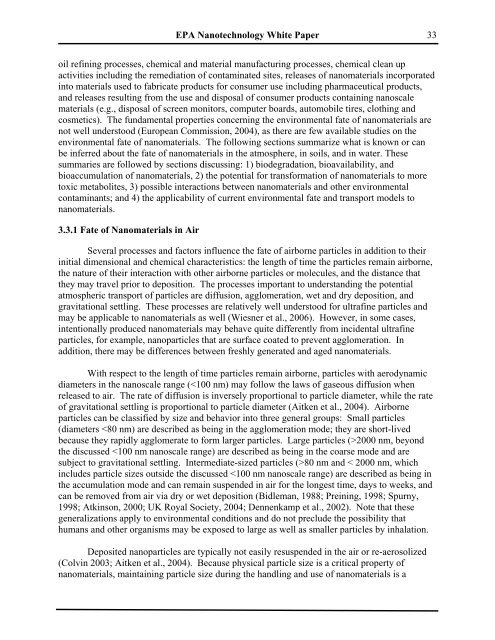Nanotechnology White Paper - US Environmental Protection Agency
Nanotechnology White Paper - US Environmental Protection Agency
Nanotechnology White Paper - US Environmental Protection Agency
Create successful ePaper yourself
Turn your PDF publications into a flip-book with our unique Google optimized e-Paper software.
EPA <strong>Nanotechnology</strong> <strong>White</strong> <strong>Paper</strong><br />
oil refining processes, chemical and material manufacturing processes, chemical clean up<br />
activities including the remediation of contaminated sites, releases of nanomaterials incorporated<br />
into materials used to fabricate products for consumer use including pharmaceutical products,<br />
and releases resulting from the use and disposal of consumer products containing nanoscale<br />
materials (e.g., disposal of screen monitors, computer boards, automobile tires, clothing and<br />
cosmetics). The fundamental properties concerning the environmental fate of nanomaterials are<br />
not well understood (European Commission, 2004), as there are few available studies on the<br />
environmental fate of nanomaterials. The following sections summarize what is known or can<br />
be inferred about the fate of nanomaterials in the atmosphere, in soils, and in water. These<br />
summaries are followed by sections discussing: 1) biodegradation, bioavailability, and<br />
bioaccumulation of nanomaterials, 2) the potential for transformation of nanomaterials to more<br />
toxic metabolites, 3) possible interactions between nanomaterials and other environmental<br />
contaminants; and 4) the applicability of current environmental fate and transport models to<br />
nanomaterials.<br />
3.3.1 Fate of Nanomaterials in Air<br />
Several processes and factors influence the fate of airborne particles in addition to their<br />
initial dimensional and chemical characteristics: the length of time the particles remain airborne,<br />
the nature of their interaction with other airborne particles or molecules, and the distance that<br />
they may travel prior to deposition. The processes important to understanding the potential<br />
atmospheric transport of particles are diffusion, agglomeration, wet and dry deposition, and<br />
gravitational settling. These processes are relatively well understood for ultrafine particles and<br />
may be applicable to nanomaterials as well (Wiesner et al., 2006). However, in some cases,<br />
intentionally produced nanomaterials may behave quite differently from incidental ultrafine<br />
particles, for example, nanoparticles that are surface coated to prevent agglomeration. In<br />
addition, there may be differences between freshly generated and aged nanomaterials.<br />
With respect to the length of time particles remain airborne, particles with aerodynamic<br />
diameters in the nanoscale range (

















